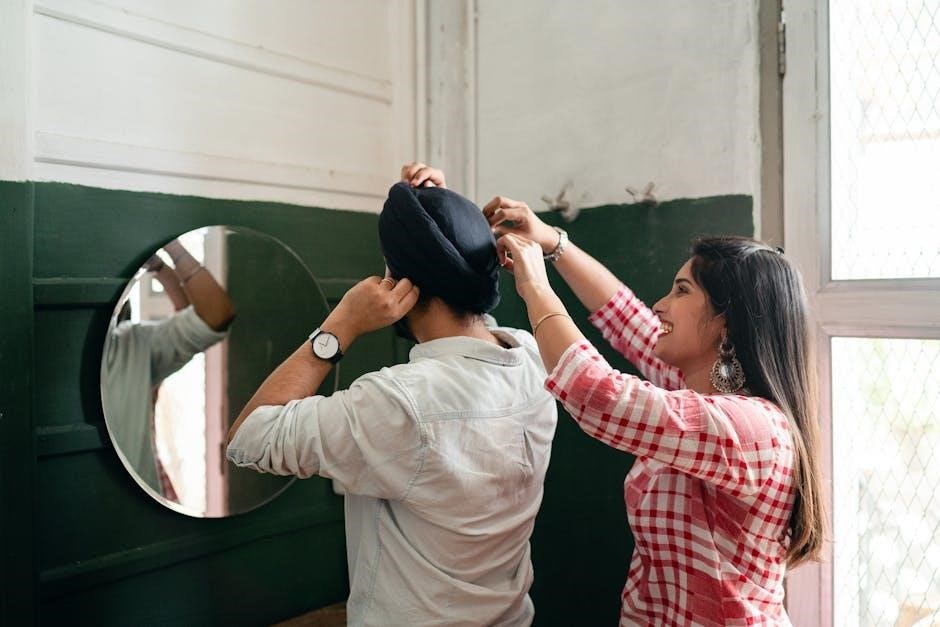A well-fitted dress shirt enhances professionalism and comfort. Understanding sizing involves key measurements like neck, chest, and sleeve length, ensuring a polished and tailored appearance for every occasion.
Understanding the Importance of Proper Fit
A proper fit is essential for both comfort and style. It ensures confidence, creates a balanced appearance, and prevents discomfort. Accurate measurements are crucial to avoid a too-tight or too-loose fit, guaranteeing the shirt stays neatly tucked and aligns with your body type for a polished look.
Key Measurements for Dress Shirt Sizing
The primary measurements include neck size, chest circumference, sleeve length, and wrist circumference, ensuring a tailored fit that complements your physique and personal style effectively.
Neck Size Measurement
Neck size is the foundation of a dress shirt fit, typically measured in half-inch increments. A 14-inch neck corresponds to a 14-inch collar. Stand upright, measure around the Adam’s apple, and ensure the tape isn’t too tight or loose. This measurement determines the shirt’s overall fit and comfort.
Chest Measurement
Chest measurement ensures the shirt fits comfortably across the torso. Measure around the broadest part of the chest, keeping the tape level and relaxed. This measurement, often included in size charts, helps determine the shirt’s width and ensures a balanced fit alongside neck and sleeve measurements for optimal comfort and appearance.
Sleeve Length Measurement
Sleeve length is crucial for a proper fit, ensuring the shirt extends to the wrist bone when arms are relaxed. Measure from the center back of the neck, over the shoulder, to the wrist. Accurate sleeve length prevents a too-short or overly long appearance, enhancing both comfort and style significantly in dress shirts.
Waist Measurement
The waist measurement ensures the shirt fits comfortably around the midsection. Measure around the natural waistline, keeping the tape straight and level. This measurement helps determine the shirt’s taper, preventing a boxy or overly tight fit. Accurate waist sizing is key for a balanced, flattering silhouette in dress shirts.
Dress Shirt Size Charts Explained
Dress shirt size charts guide you through measurements and fits, ensuring accuracy. They detail neck, chest, and sleeve lengths, helping you choose the perfect fit for your body type and style.
Standard Fit Size Chart
The standard fit size chart offers a classic, comfortable cut with a relaxed silhouette. It includes measurements for neck, chest, and sleeve length, providing a versatile fit that suits most body types. Ideal for those who prefer a traditional look without excessive tightness, ensuring ease of movement and a timeless appeal.
Slim Fit Size Chart
The slim fit size chart caters to a contemporary, streamlined look, offering a narrower cut through the chest and waist. It features tailored measurements, creating a modern, youthful appearance while maintaining comfort. Ideal for slimmer builds, the slim fit is perfect for fashion-forward individuals seeking a sharp, sophisticated style without compromising on mobility.
Modern Fit Size Chart
The modern fit size chart offers a balanced, tailored silhouette, blending comfort with style. Designed for a slightly broader chest and waist compared to slim fit, it suits muscular or athletic builds while maintaining a contemporary look. Measurements are proportionate, ensuring a sharp, polished appearance without sacrificing ease of movement or versatility.
How to Choose the Right Fit for Your Body Type
Selecting the right fit involves considering your body type. Classic fits suit broader builds, slim fits are ideal for lean frames, and modern fits offer a balanced, tailored look. Choose according to your physique for optimal comfort and style.
Classic Fit
A classic fit dress shirt offers a looser, more relaxed cut with a boxier shape, providing comfort and ease of movement. It suits broader builds and larger body types, ensuring a comfortable fit while maintaining a professional appearance. The classic fit is ideal for those who prefer a traditional, timeless style with ample room.
Slim Fit
A slim-fit dress shirt is tailored closer to the body, offering a contemporary look. It features narrower sleeves, a fitted chest, and a slightly shorter waist; Designed for slimmer builds or those seeking a modern aesthetic, slim-fit shirts eliminate excess fabric while maintaining mobility and style, ideal for a sleek, polished appearance.
Modern Fit
A modern-fit dress shirt offers a balanced silhouette, slightly tapered for a contemporary look without being overly restrictive. It provides ease of movement while maintaining a streamlined appearance, ideal for men seeking a versatile fit that works well with both formal and casual attire, ensuring comfort and style across various body types.
Additional Factors Influencing Fit
Fabric type, stretch, and shirt length impact fit. Thinner fabrics drape differently, while stretch enhances comfort. Shirt length affects styling and tucking, ensuring a polished, tailored appearance regardless of body type.
Fabric Type and Stretch
Fabric type significantly impacts fit. Cotton offers breathability, while polyester blends provide durability. Stretch fabrics enhance flexibility, ensuring comfort without compromising style. Understanding fabric properties helps choose shirts that drape well and maintain shape, ensuring a polished appearance tailored to individual preferences and body types.
Shirt Length and Style
Shirt length and style affect both fit and versatility. Longer shirts stay tucked, while shorter styles offer a modern look. Slim-fit shirts have a tailored cut, while classic fits are more relaxed. Choosing the right length ensures the shirt complements body type and intended outfit, whether formal or casual.
Measuring Tips for Accuracy
Use a flexible tape measure, ensure the shirt is buttoned, and measure around the neck, chest, and waist. Keep the tape snug but not tight for the best fit.
How to Measure Your Neck
To measure your neck, place the tape measure around the base of your neck, just above the collarbone. Keep the tape snug but not tight, with the measure parallel to the floor. Ensure the tape is level and not twisted for an accurate reading, which is crucial for determining your dress shirt size.
How to Measure Sleeve Length
Measure sleeve length from the center back of your neck, over your shoulder, and down to your wrist. Keep your arm relaxed by your side. Ensure the tape is straight and not twisted. This measurement ensures sleeves fit comfortably, neither too short nor too long, complementing your overall shirt fit perfectly.
How to Measure Chest and Waist
Measure your chest by wrapping a tape measure under your armpits, across the fullest part of your chest, and around your back. For waist, measure naturally at the narrowest point, usually just above the hipbone. Both measurements ensure a shirt that fits comfortably without being too tight or loose, providing a tailored look.

International Sizing Differences
US and British sizing uses neck and sleeve length, while European sizes focus solely on neck measurements, simplifying fits but requiring careful conversions for global shoppers.
US vs. European Sizing
US sizing includes both neck and sleeve length, while European sizes focus on neck measurements. American shirts often list two numbers (e.g., 14 32/33), indicating neck and sleeve length, whereas European sizes use a single number for neck size, with sleeve length typically standardized. This difference requires careful conversion for accurate global fits.
Converting Sizes Across Regions
Converting men’s dress shirt sizes between regions requires understanding local measurement standards. Use size charts to align US neck and sleeve lengths with European neck-only sizing. For example, a US size 14 32/33 may correspond to a European neck size 36. Accurate conversion ensures the best fit when shopping internationally.
Common Mistakes to Avoid
Overlooking sleeve length and ignoring chest measurements are common errors, leading to an ill-fitting shirt. Ensure accurate measurements for a tailored look and optimal comfort.
Overlooking Sleeve Length
Ignoring sleeve length leads to poor fit, with sleeves appearing too short or excessively long. Measure from the center back to the wrist for accuracy, ensuring comfort and a tailored look.
Ignoring Chest Measurements
Neglecting chest measurements results in a shirt that is too tight or overly loose. Proper chest measurement ensures optimal fit, allowing freedom of movement while maintaining a streamlined appearance.

Tools and Resources for Sizing
Utilize size charts, measurement guides, and online calculators to determine your fit. Templates and detailed resources help ensure accurate sizing for a perfect dress shirt fit.
Using a Size Chart Template
A size chart template provides precise measurements for neck, chest, sleeve, and waist. It helps ensure accurate fitting by comparing your measurements to standard sizes, avoiding sizing mistakes and ensuring a perfect fit. Downloadable templates or online tools simplify the process, offering a clear guide to determine your ideal dress shirt size effortlessly.
Online Size Guides and Calculators
Online size guides and calculators simplify finding your perfect fit. They use measurements like neck, chest, and sleeve length to recommend sizes, often comparing across brands. Interactive tools ensure accuracy, reducing guesswork and enhancing shopping convenience for men seeking tailored dress shirts that fit flawlessly.

How Dress Shirts Fit with Other Clothing
A well-fitted dress shirt complements suits, blazers, trousers, and jeans, ensuring a streamlined, polished appearance. Proper fit ensures the shirt stays tucked in, maintaining a balanced look with tailored pieces.
Pairing with Suits and Blazers
A dress shirt should fit seamlessly under a suit or blazer, with the collar complementing the lapel style. Ensure the shirt is tucked in and the sleeves are proportionate to the jacket’s length. Proper measurements guarantee a polished look, while fabric choice ensures comfort and style alignment with formal attire.
Matching with Trousers and Jeans
A perfectly fitted dress shirt complements both trousers and jeans; For trousers, ensure the shirt stays tucked with a tailored waistline. For jeans, a slightly untucked fit with a slim style creates a casual yet polished look, balancing comfort and aesthetics. Proper measurements ensure versatility across different bottom styles.

Popular Brands and Their Sizing
Brands like Brooks Brothers and Calvin Klein offer consistent sizing, while others may vary. Always refer to specific charts for accuracy, ensuring the best fit for your body type.
Understanding Brand-Specific Fits
Each brand tailors fits to suit different body types. Slim-fit brands like Calvin Klein offer a narrower cut, while classic-fit brands provide a more relaxed silhouette. Always check brand-specific size charts to ensure the best fit, as variations can significantly impact comfort and appearance.
Comparing Sizes Across Brands
Comparing sizes across brands can be tricky due to differing fits. For instance, a medium at Calvin Klein may not match a medium at Ralph Lauren. Always refer to each brand’s specific size chart to ensure accurate measurements, as sizing standards vary between brands, impacting your final fit and comfort.
A perfect fit enhances confidence and style. Accurate measurements and understanding fit types ensure the right dress shirt for any occasion, making you look and feel polished.
Final Tips for a Perfect Fit
Ensure accurate measurements, consider fabric stretch, and compare sizes across brands. Opt for a slightly tailored fit to avoid excess fabric. Always check shirt length to stay tucked in. Use size charts as a guide but trust your fit preference for ultimate comfort and style confidence.




